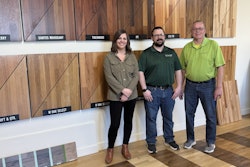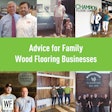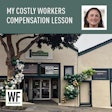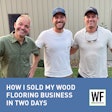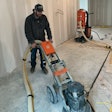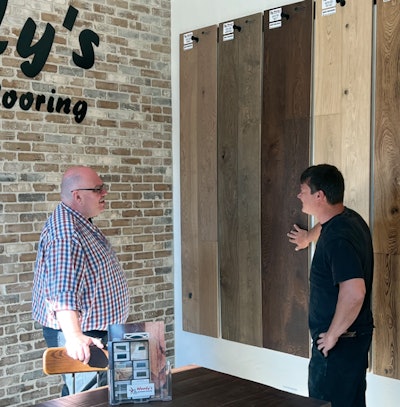
Sales is the heartbeat of the company. No sales, no heartbeat. If you can’t sell yourself first, then your floor, your chance of succeeding in business is very, very low. Selling is not just selling wood to clients. You need to sell yourself to your staff, your suppliers and anyone else you are associated with to make your company a success.
I’ve never taken a sales course; I have read a few books, and everything I’ve learned has been self-taught. I tell our staff who work with us that there are two books that I think are outstanding: One is called “How to Win Friends and Influence People” (the famous book by Dale Carnegie), and the other book is called “The Art of the Deal” (you don’t have to love or hate Donald Trump to read this book; I think it’s full of good lessons on selling yourself to make a deal). Here are some of things I’ve learned about successful selling:
Be confident
The No. 1 thing I’ve learned about selling is confidence: confidence in yourself and confidence in your product. If you don’t know your products and your procedures inside out and have an answer for every question, your customer will pick up on this really quick, and there’s a good chance you lost your ability to close the sale.
Demonstrate respect
This is how I approach an estimate at a customers home. First, my vehicle has to be clean (it doesn’t have to be new, just clean). When the customer answers the door, I take my shoes off and leave them outside. No exceptions. It shows total respect for their home. You’ll notice how I call it a “home,” not a “house.” The reason is you build a house, but you live in a home.
Show you’re an expert
I then greet the customer as I’m stepping into their home, and if it’s a sand and refinish I immediately look down at the floor and tell them exactly what kind of floor they have. For example: “I see you have a 2¼-inch red oak select-and-better solid-stock hardwood with an oil-based finish on it.” This usually impresses them for two reasons: They see you know your stuff, and you have an interest in their home. Remember, you are now in their home and their domain, and they are very protective of it. I then immediately give them my business card so they know who they are talking to. I usually don’t spend a lot of time with small talk; I try to give them as much information as I can about their floors and what they need us to do. I never oversell a job! Once I know they are committed, I stop selling and talk about the process, which makes them feel more comfortable and excited to get to the next step.
Consider writing estimates immediately
Something I always do and encourage our salespeople to do is write out the estimate right there and leave a copy with the potential customers. This usually impresses them and shows huge confidence. It also helps you talk longer with the homeowner and saves doing work when you get back to office, and it helps prevent forgetting to include something on your estimate.
I’ve been halfway through working on a floor in a customer’s house when they come to tell me they just received the estimate from our competitor in their email … and we’ve already got part of the job already done! The point being: Don’t be tardy on getting the estimate to the customer, they are wanting something done, and you need to respond quickly.
When I’ve written out my estimate in their home, I set it down right between the couple instead of handing it to one of them. The reason is that the person who reaches out and pulls the estimate toward them is the one who is making the decisions, and that’s always good information to have.
Try to understand what customers are thinking
I try to figure out what the customer is thinking, always having my feelers out for the direction they are leaning toward. I’ll tell you an example: When a good comedian goes on stage, watch how he reads the crowd in the first 30 seconds. He will say three jokes in a row, maybe one about the mother-in-law, another about politics and maybe another that is sexual. He will then see which one of these categories the crowd reacted best to, and then immediately change his script in his mind to fit what they responded to. This is exactly how salespeople need to read their customers.
Paint the picture of the future
Another huge confidence builder for the customer is something I tell them at the very end of an estimate: “I don’t think you realize how much this is going to change the look in your home. It’s going to be beautiful.” It’s true (of course), and they love it when they can tell you have an interest in their home.
Analyze your close rate
Should you get all the jobs you price? No. I believe a perfect close rate is between 55–70%. If you are lower than 50%, something is not working, whether that’s your pricing or your sales ability. If you are more than 70%, then you’re simply working too cheap—put your price up!
Know that not everyone should be your customer
This has been proven to me over and over again: If you are working for a builder or contractor and their organization is a mess and their job site is a mess, well, guess what? Their checkbook is a mess, too. Don’t feel bad about declining to work for someone if you feel they might not be up to your standards in quality and profitability. You can waste more time with these kind of customers and end up losing valuable time when you could be working with good customers. Try to remember the 80/20 rule: You get 80% of your profits from 20% of your customers. Don’t spend 80% of your time dealing with the customer that only gives you 20% of your profit.
Keep your own social media clean
If you are trying to sell high-end jobs with high-end margins, you need to keep your personal social media clean. In today’s world of social media, when you are dealing with a customer, the first thing they will do when you leave is search you out on social media—not just your business, but you personally. Your quality of lifestyle on social media should match your quality of flooring you are selling.
These are a few things I have learned in the past 37 years of being in the wood flooring business, and of course there is a lot more to know (and I’m still always learning). But I hope my experiences can help someone else be successful. Remember, we’re not competition in this business, we’re here to help.















